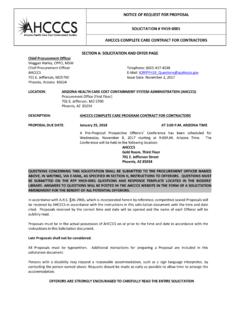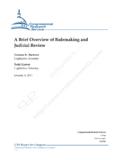Transcription of NOTICE OF FINAL RULEMAKING - azahcccs.gov
1 1 NOTICE OF FINAL RULEMAKING TITLE 9. HEALTH SERVICES CHAPTER 22. ARIZONA HEALTH CARE COST CONTAINMENT SYSTEM ADMINISTRATION PREAMBLE 1. Article, Part, or Section Affected (as applicable) RULEMAKING Action: R9-22-701 Amend Amend Amend Amend Amend Amend Amend Amend 2. Citations to the agency s statutory RULEMAKING authority to include both the authorizing statute (general) and the implementing statute (specific): Authorizing statute: (F) Implementing statute: (G)(3) and (G)(12) 3. The effective date of the rule: The agency selected an effective date of October 1, 2016 as specified in 41-1032(B) to coincide with the start of the contract year between the AHCCCS Administration and managed care contractors that make the majority of hospital payments.
2 Thus good cause exists for this effective date and the effective date will not harm the public interest. 4. Citations to all related notices published in the Register to include the Register as specified in R1-1- 409(A) that pertain to the record of the FINAL RULEMAKING package: NOTICE of RULEMAKING Docket Opening: 22 784, April 8, 2016 NOTICE of Proposed RULEMAKING : 22 761, April 8, 2016 2 5. The agency s contact person who can answer questions about the RULEMAKING : Name: James Maguire Address: 701 E. Jefferson St. Telephone: (602) 417-4232 Fax: (602) 253-9115 E-mail: Web site: 6. An agency s justification and reason why a rule should be made, amended, repealed or renumbered, to include an explanation about the RULEMAKING : The proposed RULEMAKING will amend and clarify rules regarding payments to hospitals for inpatient and outpatient services.
3 Specifically, this RULEMAKING increases payments for inpatient and outpatient services provided during a one year period to hospitals that participate in a qualifying health information exchange and have been certified as having achieved meaningful use stage 2 with respect to the hospital s use of the health information exchange. The payment adjustments reward hospitals that have made the investment necessary to implement an effective system of electronic health records retention and exchange which actions are expected to improve patient health outcomes and reduce of the cost of care. In addition, the proposed RULEMAKING refines the Service Policy Adjustor associated with claims for inpatient hospital services provided to certain high-acuity children; clarifies payments for inpatient hospital services after a patient is transferred to another hospital to receive sub-acute care; and clarifies reimbursement for inpatient hospital services designated as administrative days that is, when a patient must be admitted or cannot be safely discharged due to the unavailability or an appropriate setting outside the hospital.
4 7. A reference to any study relevant to the rule that the agency reviewed and either relied on or did not rely on in its evaluation of or justification for the rule, where the public may obtain or review each study, all data underlying each study, and any analysis of each study and other supporting material: A study was not referenced or relied upon when revising these regulations for. 3 8. A showing of good cause why the RULEMAKING is necessary to promote a statewide interest if the RULEMAKING will diminish a previous grant of authority of a political subdivision of this state: Not applicable. The RULEMAKING will not diminish a previous grant of authority of a political subdivision. 9. A summary of the economic, small business, and consumer impact: The Administration anticipates a moderate economic impact on the implementing agency, small businesses and consumers for the rule changes: The Administration anticipates that the adjustments to payments for inpatient and outpatient hospital services due to Value Based Purchasing (VBP) will result in approximately $ million of additional payments for the contract year October 1, 2016 through September 30, 2017 to about 19 qualifying hospitals that have met the criteria in the rule for implementation and use of electronic health records and health information exchange.
5 The Administration amended rule to clarify the description of how DRG payments are made, including transplant services. The amended rule also clarifies how DRG payments are made for Administrative days and transfers. These changes are not expected to have an economic impact on any party since the changes are only for clarification and do not change a service or payment. The revisions to the rules will enhance the public s understanding. In addition, the Administration refined the high acuity pediatric policy adjustor for January 1, 2016 to recognize the higher cost of treating higher acuity pediatric patients. It is anticipated that the high acuity pediatric policy adjustor will result in annual additional payments of $ million to 53 hospitals.
6 10. A description of any changes between the proposed RULEMAKING , to include supplemental notices, and the FINAL RULEMAKING : 4 No changes were made between the proposed RULEMAKING and the FINAL RULEMAKING , with exception of the technical change of removing the term comprehensive from the definition of subacute services as requested by a commenter. 11. An agency s summary of the public or stakeholder comments made about the RULEMAKING and the agency response to the comments: The following comments were received as of the close of the comment period of May 9, 2016. Item # Rule Cite Line # Comment From and Date rec d. Comment Analysis/ Recommendation 1. R9-22-701 William Timmons 05/04/16 The word comprehensive could mean different things to different individuals with their interpretation related to whether they work for a hospital or a health care plan.
7 Thus, any attempt to define comprehensive would be difficult. For these reasons the word comprehensive adds no value to the definition and should be removed. The phrase instead of is key since it supports our pursuit of direct admissions to both hospitals so we don t have to rely just on transfers from tertiary care hospitals. The definition needs to include what it is not, , it is not the type/level of care provided in a skilled nursing facility. The preferred definition is: Sub-acute services means inpatient care for a patient with an acute illness, injury or exacerbation of a disease process when the patient does not require acute inpatient hospitalization but requires care at a level beyond that provided by a skilled nursing facility.
8 Sub-acute care is rendered immediately after or instead of acute inpatient hospitalization. The Administration has agreed to remove the term comprehensive , however, the Administration declines the suggestion to make other revisions to the definition of sub-acute services. Sub-acute services may include the level of services provided at a nursing facility, thus the recommendation to include care at a level beyond that provided by a skilled nursing facility will not be added. Nursing facilities are permitted to render sub-acute services. The federal description of nursing facility services in 42 CFR provides that nursing facility services are services provided to persons who do not require hospital care but whose condition requires services above the level of room and board. 2. William Timmons 05/04/16 Add the following information from the payment policies manual that AHCCCS published on October 30, 2015, this would add clarity which is important since we want to make sure that tertiary care hospitals are incentivized to transfer patients to LNH and HCH.
9 Clarification regarding transfers for sub-acute services: A recipient who no longer meets medical inpatient criteria may be discharged/transferred to another acute care facility without triggering a reduction to the transferring hospital via the 70 Discharge Status The Administration has noted your comment. Hospitals that participate in AHCCCS are required to sign provider participation agreements which agreement incorporates by reference several policy manuals. Those policy manuals provide clarification and detail regarding billing instructions. Billing instructions are generally delineated in policy. Therefore, additional language is not necessary. 5 Code (Discharge/transfer to another type of health care institution not defined elsewhere in the code list) for the provision of sub-acute services.
10 3. William Timmons 05/04/16 A2 use of the term other in this context would seem to imply that nursing facility provides sub-acute services as defined in R9-22-701. There is a difference between the levels of care provided by skilled nursing facilities and hospitals providing sub-acute services. To avoid possible confusion I suggest restating A2: Administrative days may also occur at the end of an acute care episode, for example, when a member is not discharged while awaiting placement in a post-acute care setting, such as a nursing facility or a hospital providing sub-acute services. The Administration declines to make the suggested change. Nursing facilities are not precluded from rendering sub-acute services. The federal description of nursing facility services in 42 CFR provides that nursing facility services are services provided to persons who do not require hospital care but whose condition requires services above the level of room and board.



















